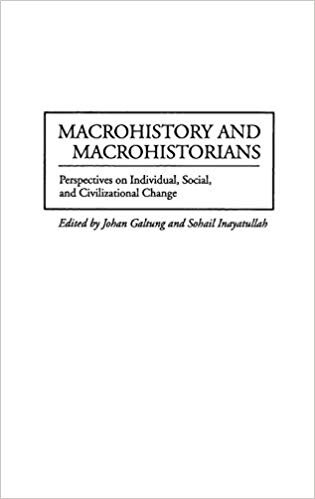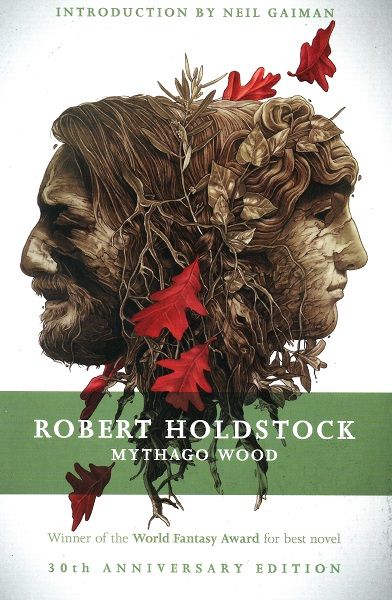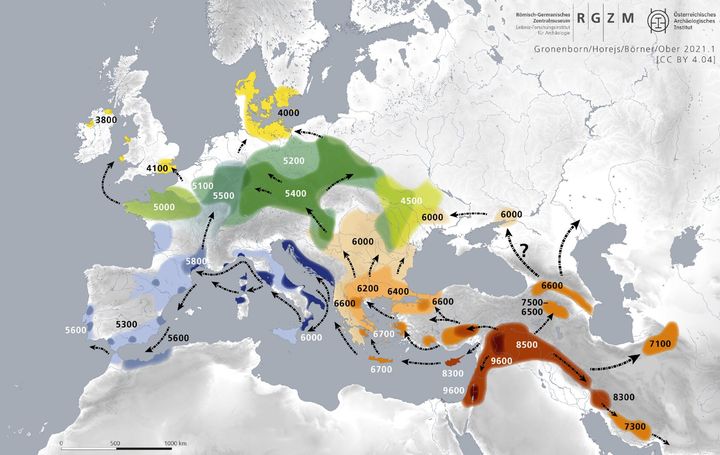The Long View: Macrohistory and Macrohistorians: Perspectives on Individual, Social, and Civilizational Change
This is a very early book review by John J. Reilly. I’ve done something I don’t usually do, which is add links in to John’s work. In this case, it made sense, because John discussed almost all of the authors listed in this textbook at some point in the next fifteen years. Some of them got a deeper look, and I’ve pointed there where I can.
If nothing else, this book review is useful just for summarizing so many historical models in a phrase.

Macrohistory and Macrohistorians:
Perspectives on Individual, Social, and Civilizational Change
Edited by Johan Galtung and Sohail Inayatullah
Praeger Publishers, 1997
274 Pages, $65.00
ISBN: 0-275-95755-1
Let me say the worst first. This book is profoundly disappointing. It is unevenly written and factually unreliable. Because it seeks to be a serious, wide-ranging treatment of its topic for an academic readership, there is some danger that students and instructors will be put off from macrohistory by first encountering it in this form. This would be very unfortunate, since the subject is both important and interesting.
Macrohistory is history on the large scale, telling the story of whole civilizations or of the entire world. Such histories are often, though not invariably, used to showcase theories of history. Truly universal theories of history try to explain why the human world has developed as it has. They also usually give some hint about how it will develop in the future. Other macrohistorians don't see the whole world as having a single story, but try to set out general rules about how the largest coherent social units, such as empires, dynasties or civilizations, have behaved in the past and can be expected to behave in the future. Reasonable people differ about whether macrohistory can be anything more than a species of literature, but most people who pursue the subject find that macrohistories repay study. Some of them might even be true.
This brings us to "Macrohistory and Macrohistorians." The book offers brief summaries, by a variety of contributors, of the ideas of 20 macrohistorians. The macrohistorians are from many periods and cultures, though most are modern and Western. Here is the full list, with a word or two about the model each proposed:
Ssu-Ma Ch'ien (most famous of Chinese historians, who wrote of dynastic cycles),
St. Augustine of Hippo (sometimes called "the father of progress," his model ensured the Western view of time would be predominately linear rather than cyclical),
Ibn Khaldun (Muslim historian with a generational model of dynastic change),
Giambattista Vico (one of the great cyclical theorists of the West),
Adam Smith (psychology, history and markets),
George Wilhelm Friedrich Hegel (history as the development of consciousness),
Auguste Comte (a three step model resulting in a secular-scientific final state),
Karl Marx (history as the conflict of classes),
Herbert Spencer (the most famous "Social Darwinist"),
Vilfredo Pareto (mass psychology and the "circulation of elites"),
Max Weber (the evolution of institutions from charismatic leadership to bureaucratic routine),
Rudolf Steiner (a very long-term model of spiritual evolution),
Oswald Spengler (the chief proponent of civilizations as mortal, organic entities),
Pierre Teilhard de Chardin (biological and human history progress to the perfect Omega Point),
Pitrim Sorokin (the cyclical modelist who did the most original research),
Arnold Toynbee (his "Study of History" sought to combine the linear and cyclical approaches, becoming the longest book of the 20th century in the process),
Antonio Gramsci (a subtle Marxist),
Prabhat Rainjar Sarkar (a relatively small-scale cyclical modelist, founder of the Ananda Marga movement),
Riane Eisler (ecofeminism),
Christopher B. Jones (a model incorporating the Gaia Hypothesis)
There is no point in quarreling about who gets included in a list like this, though it might seem that some of these writers were really sociologists whose work merely implied a theory of history. As with choices for the "best 100 books of the century," everyone is likely to have personal favorites. In any case, the editors seem to have intended the book for something more than a mere survey. Johan Galtung is Professor of Peace Studies at the University of Hawaii, Universitet i Troms” and Universitat Witten/Herdecke, while Sohail Inayatullah is senior research fellow at the Communication Centre of the Queensland University of Technology of Brisbane, Australia, and a fellow and executive council member of the World Futures Studies Federation. What they were looking for was ways to imagine social transformation, which is something that you might reasonably expect macrohistorians to provide.
After the summaries of the 20 macrohistorical models, the editors compare and contrast them. They look for the level of free will each allows, the roles played by "change agents" (who might be economic classes, "Great Men" or divine avatars), and the way that the models periodize history. They are also interested in whether the models are cyclical (so that the future is going to resemble some period in the past) or linear (so that real novelty is possible as history progresses) or both. Another important point is whether any given model allows for "exits," that is, whether it allows for important events outside itself, either after the end of the historical process the model describes or simultaneously with that process. At the end of the book there is an appendix of "graphs" which seek to illustrate the basic structure of each model.
Now, conceptually, this is all interesting and useful. The problem is that the execution is occasionally maddening. I defy anyone familiar with St. Augustine's model of history, for instance, to recognize it in the description given here. (Also a bit peculiar is the assertion that Augustine wrote his chief work, "The City of God," because he had been challenged on whether Christianity was "an efficient guardian of the best interests of the ruling class"). All the other models that I know something about are also garbled, though not so badly. What is truly shocking about this book, though, is that there is no discussion of millenarian and apocalyptic elements in historical models. These have been among the key cultural determinants of history for at least the last two millennia, both in the West and elsewhere. What is even more bizarre is that several of the models that are discussed do indeed have such elements, but the contributors and the editors have chosen to downplay them. This is very strange.
Then there is the writing. I realize that I have my own hobby-horses when it comes to postmodern academic prose. I will not use gender-neutral language, for instance, and in general I am resistant to picking up new jargons. Sometimes I think I am just being idiosyncratic, but then I see paragraphs like this:"While the contextual nature of knowledge is obvious to us when we (as modernists, the expanded West) examine the past, when we examine our present, following Comte, we tend [sic] locate it as the rational and the scientific. The past is constructed as relative and ideological (that is, not objective), and the future is the fulfillment of truth, the final stage of history once the last vestiges, the remnants, of the religious or philosophical past have been modernized, that is, vanquished. Thus, we submit our own `present' as outside history and outside of metaphysics."
C.S. Lewis said 95% of this with the phrase "the present is also a `period.'" I really don't see why people can't write and think as clearly as that today. They should at least try. They don't in this book. On some pages, the word "discourse" occurred with a frequency like that of certain expletives in the military. Even when, as sometimes happened, the substance of the discussion was well worth reading, the merciless quality of the prose was enough to make me doubt that history would last long enough for me to read to the end of the chapter.
There are good books on the subject of macrohistory. A somewhat dated but still useful study is Frank E. Manuel's "Shapes of Philosophical History" (1965). "The Shapes of Time" (1977) by Peter Munz suffers from early whiffs of the critical blight, but is nonetheless quite readable. A great deal of excellent material has been written in recent years on millennialism and related subjects: among my favorite general treatments are Paul Boyer's "When Time Shall Be No More" and Damian Thompson's "The End of Time." In any case, if you do read "Macrohistory and Macrohistorians," please do not despair of the subject.
Copyright © 1999 by John J. Reilly
Support the Long View re-posting project by downloading Brave browser. With Both Hands is a verified Brave publisher, you can leave me a tip too!



Comments ()